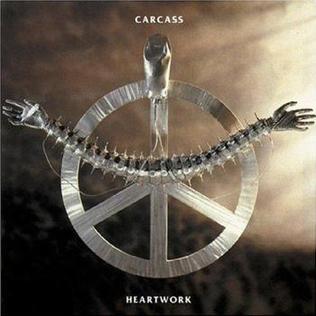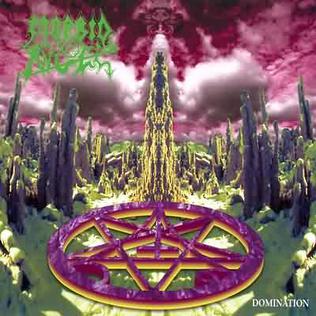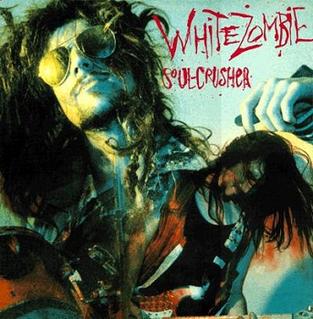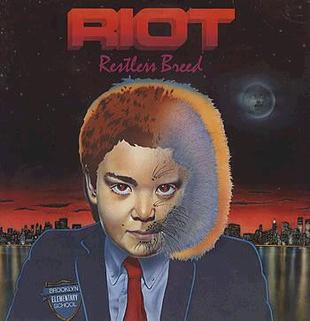
Danzig is the debut studio album by American heavy metal band Danzig, released in August 1988. The album was the first release on producer Rick Rubin's new label Def American Recordings. Def American's successor, American Recordings, reissued the album in the United States and United Kingdom in 1998. It remains the band's best-selling album having been certified gold in the U.S. in 1994, and has since been certified platinum. Danzig promoted the album with a successful world tour in 1988–1989.

Lightning to the Nations is the debut album by British heavy metal band Diamond Head. The album was recorded in 1980 and released later that year through Happy Face Records, a label owned by the producer Muff Murfin of The Old Smithy studio of Worcester, due to lack of interest from major labels and the band feeling that they needed to get the ball rolling as other bands from the same era, such as Iron Maiden and Def Leppard, were already becoming big names.

Blues for the Red Sun is the second studio album by American rock band Kyuss, released in 1992. While the album received mainly favorable reviews, it fared poorly commercially, selling only 39,000 units. It has since become a very influential album within the stoner rock genre. It was the last Kyuss album to feature bassist Nick Oliveri, who was replaced by Scott Reeder shortly after recording had been completed. The album is dedicated to Oliveri's father who died in a car accident in 1991.

Sleep is an American stoner/doom metal band from San Jose, California. Guitarist Matt Pike and bassist and vocalist Al Cisneros have been the only constant members throughout the band's history. Critic Eduardo Rivadavia describes them as "perhaps the ultimate stoner rock band" and notes they exerted a strong influence on metal in the 1990s.

Heartwork is the fourth studio album by English extreme metal band Carcass. The album was released in the UK by Earache Records on 18 October 1993, and in the United States on 11 January 1994 by Columbia Records, making it the band's only major label release. Heartwork has been described as the band's "breakthrough" and "mid-period masterpiece", as well as a landmark album in melodic death metal. The album was recorded at Parr Street Studios, Liverpool from 18 May – 21 June 1993.

Slaughter of the Soul is the fourth studio album by Swedish melodic death metal band At the Gates, released on 14 November 1995 by Earache Records. It was their last album before their eleven-year breakup from 1996 to 2007. Slaughter of the Soul is considered a landmark in melodic death metal and played a major role in popularizing the Gothenburg scene, alongside The Jester Race by In Flames and The Gallery by Dark Tranquillity. The album was recorded and mixed in Studio Fredman, early 1995.

Holy Diver is the debut studio album by the American heavy metal band Dio, released in 1983. The album was acclaimed by the music press and is the band's most successful album.

Zoot Allures is the 22nd album by the American rock musician Frank Zappa, released in October 1976 and his only release on the Warner Bros. Records label. Due to a lawsuit with his former manager, Herb Cohen, Zappa's recording contract was temporarily reassigned from DiscReet Records to Warner Bros.

Streetcleaner is the debut studio album by English industrial metal band Godflesh. It was released on 13 November 1989 through Earache Records and was reissued with a second disc of previously unreleased material on 21 June 2010. The album is widely acclaimed by critics and is often cited as a landmark release in industrial metal; though not the genre's first release, Streetcleaner helped define what industrial metal would become.

Pure is the second studio album by English industrial metal band Godflesh. It was released on 13 April 1992 through Earache Records. Though originally labeled only as industrial metal, the album has since been recognised as one of the earliest post-metal releases. Musically, Pure is rhythmically mechanical and features harsh guitars, with protracted songs and an abundance of deliberate repetition. Like much of Godflesh's music, it is regarded as particularly heavy and aggressive, and these elements helped it gain critical acclaim.

Dopesick is the third studio album by American sludge metal band Eyehategod, released on April 2, 1996. It was reissued in 2006 as part of Century Media's 10th Anniversary series with three bonus tracks that were recorded during the original Dopesick recording sessions.

Domination is the fourth studio album by American death metal band Morbid Angel, released in 1995. This was Morbid Angel's last album with Giant Records before the label dropped the band. The band then re-signed with their former label, Earache Records. This is also the first Morbid Angel album to feature Hate Eternal frontman Erik Rutan on guitars and keyboards, who later left the band following this album, though he would return to the band for Gateways to Annihilation.

Soul-Crusher is the debut studio album by American rock band White Zombie, released independently in November 1987 by Silent Explosion. It was the band's second and final release with Tom "Five" Guay on guitar. Building off the sound established on Psycho-Head Blowout, the band matured its sound while placing further emphasis on the individual roles of its players. The album caught the attention of major labels and in 1988 was adopted and re-issued by Caroline Records.

Wolverine Blues is the third studio album by Swedish death metal band Entombed, released on 4 October 1993 by Earache Records. The album displays a completely different sound from previous releases, combining elements of hard rock, heavy metal, and hardcore punk while still retaining much of their traditional, death metal roots, in a style that would later be known as death 'n' roll. The band also adopted a mid-tempo groove metal style for this release, similar to that of American band Pantera.

Electric Wizard is the debut studio album by English stoner/doom metal band Electric Wizard released in 1994 through Rise Above Records and re-released bundled with their second album, Come My Fanatics... in 1999. A remastered version was then released on CD and LP in 2006, with two bonus tracks, taken from a demo entitled Doom Chapter.

Kyuss / Queens of the Stone Age is a split EP by American rock bands Kyuss and Queens of the Stone Age, released in December 1997 on Man's Ruin Records. It features some of the final studio recordings by Kyuss while debuting former Kyuss guitarist Josh Homme's next project, Queens of the Stone Age.

Restless Breed is the fourth studio album by American heavy metal band Riot, released on May 21, 1982. It was the band's first record with vocalist Rhett Forrester. "When I Was Young" is an Eric Burdon and the Animals' cover.

Jerusalem and Dopesmoker are two versions of the third studio album by the American stoner doom band Sleep. The former title was released in 1999 by The Music Cartel and the latter was released by Tee Pee Records in 2003. The music for these albums comprises an extended hour-length piece, developed over four years and recorded in 1996 under the auspices of Sleep's label at the time, London Records. When recording had completed, London was unhappy with the finished product and refused to release it, leading to Sleep's disbandment and the album surfacing on bootlegs and unauthorized indie releases in subsequent years. All versions of the album received very positive reception from music critics, who described it as a high-water mark in both the stoner metal and doom metal genres.

















